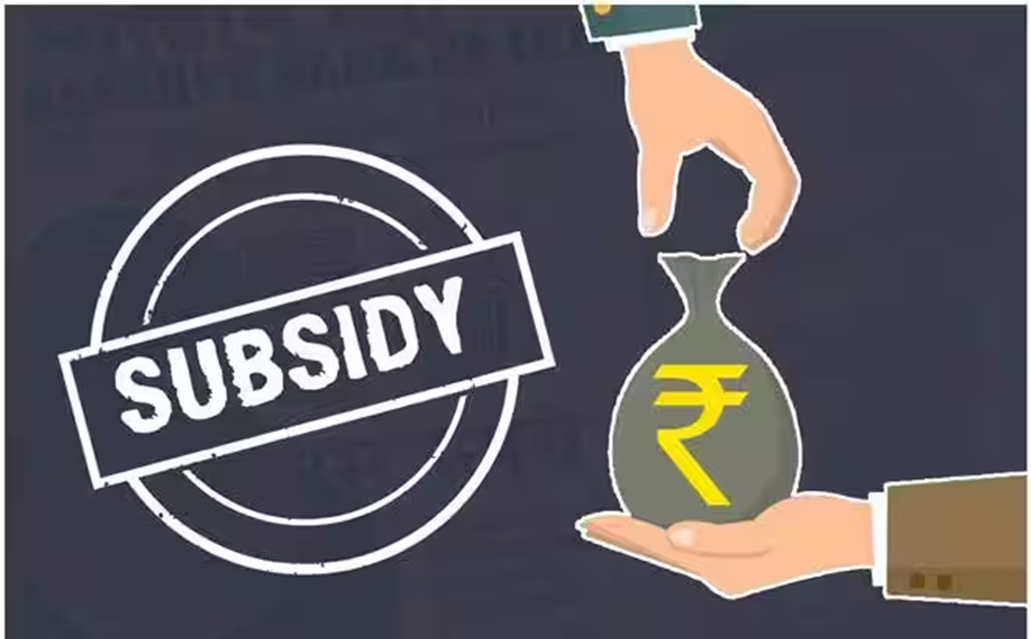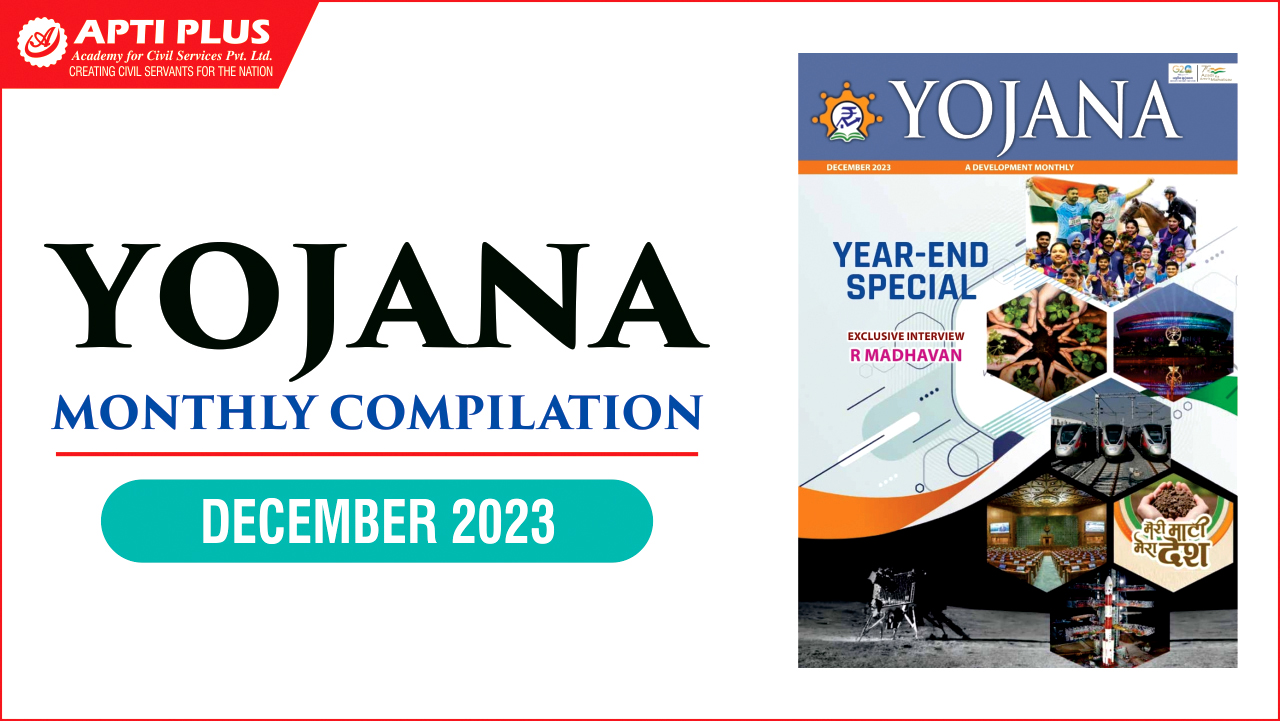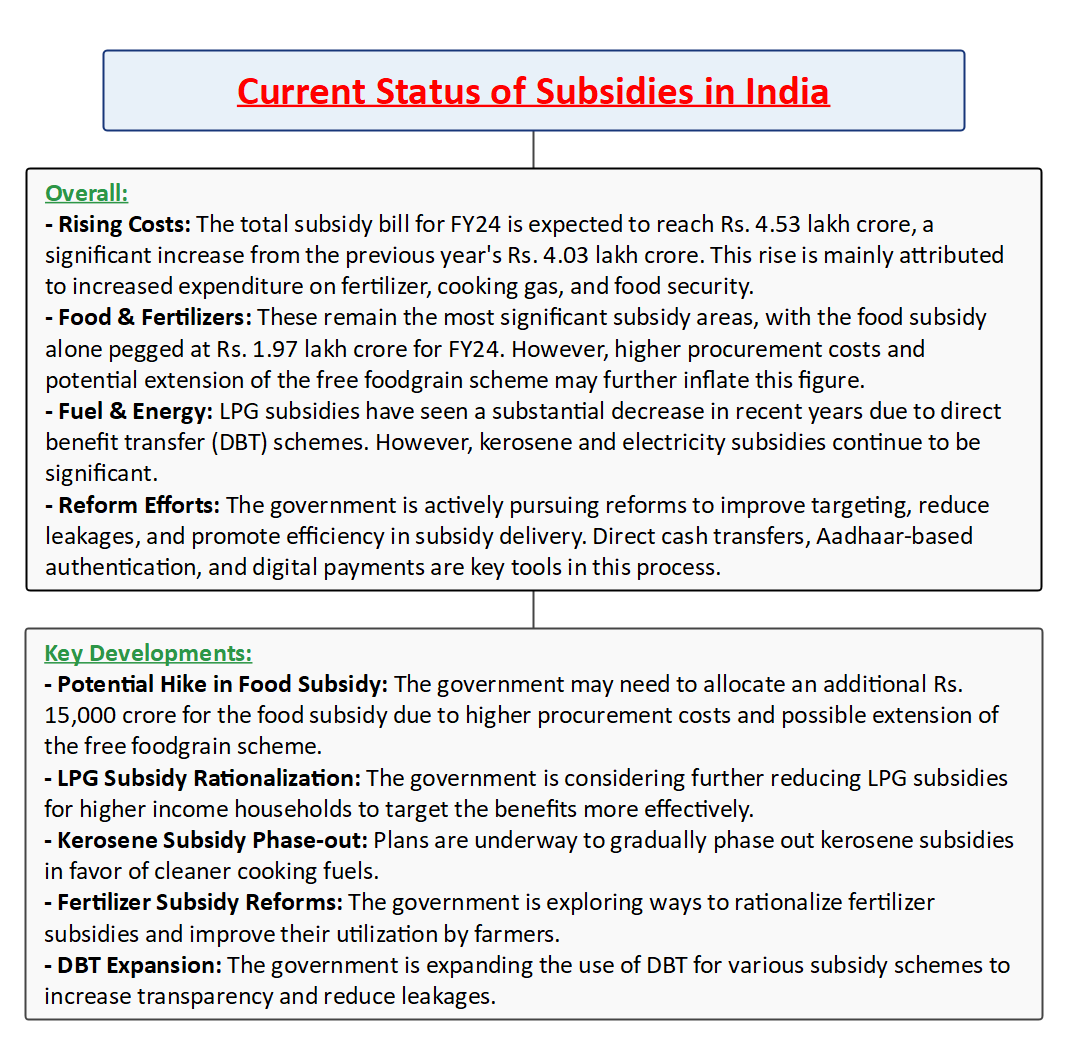Description

Copyright infringement not intended
Picture Courtesy: www.financialexpress.com
Context: The increase in the subsidy bill for the government's second term compared to the first term can be attributed to several factors, including changes in global economic conditions, policy decisions, and external events like the COVID-19 pandemic and the Russia-Ukraine war.
Key Highlights
2014-2019
- During 2014-2019, there was a focus on launching schemes aimed at universal access to essential goods and services like housing, sanitation, banking, electricity, and cooking gas connections. This period saw what was termed "new welfarism," where public funding increased for these services.
- Despite increased funding for welfare schemes, the subsidy bill decreased in absolute terms and relative to GDP from 2014 to 2019. This reduction was primarily due to benign international oil and fertiliser prices, which allowed the government to trim fuel and fertiliser subsidies.
After 2019
- The subsidy bill started increasing during 2019-24 due to policy decisions. The government decided to fully fund food and fertiliser subsidies, which were previously only partially funded. This led to a spike in the overall subsidy tab in 2020-21.
- The Finance Minister made a one-time provision to help entities like the Food Corporation of India (FCI) and fertiliser firms clear their outstanding loans, resulting in increased subsidy spending.
Impact of COVID-19 Pandemic
- The COVID-19 pandemic led to economic distress, prompting the government to increase support through subsidies and transfers. There was a record offtake of rice and wheat through the public distribution system (PDS), with the government doubling the monthly grain quota for beneficiaries.
- Spending on schemes like the Mahatma Gandhi National Rural Employment Guarantee Act (MNREGA) also rose significantly as the government aimed to provide employment opportunities during the economic downturn caused by the pandemic.
Russia-Ukraine War
- The Russia-Ukraine war had an impact on international fertiliser prices. Prices of imported fertilisers surged significantly during this period.
- To shield farmers from the impact of rising fertiliser prices, the government chose not to pass on the increased costs, leading to a near-doubling of the fertiliser subsidy between 2020-21 and 2022-23.
|
The increase in the subsidy bill can be attributed to a combination of policy decisions, external factors like the COVID-19 pandemic and the Russia-Ukraine war, and the government's commitment to supporting farmers and vulnerable sections of society through subsidies and transfers.
|
Future Outlook
- The government is unlikely to tamper with certain prices, such as those of urea, wheat, and rice, in the upcoming Interim Budget for 2024-25.
- There may be considerations to increase direct benefit transfers (DBT) under schemes like PM-Kisan ahead of the Lok Sabha polls, but any significant rationalisation of subsidies may be deferred to the next government.

Subsidies
- Subsidies in India play a crucial role in supporting various sectors of the economy, promoting social welfare, and ensuring equitable development. They are financial assistance provided by the government to individuals, industries, or sectors to encourage specific activities or to address particular challenges.
Types of Subsidies
- Agricultural Subsidies: The government provides subsidies on fertilizers to make them affordable for farmers, aiming to boost agricultural productivity. To protect farmers from crop failures and natural disasters, the government subsidizes premiums for crop insurance schemes.
- Food Subsidies: The government provides subsidized food grains (rice, wheat, etc.) to eligible households through a network of fair-price shops. Subsidies are provided to ensure that school children receive nutritious meals, promoting both education and nutrition.
- Petroleum Subsidies: The government subsidizes cooking gas (LPG) to make it affordable for households. Subsidies on kerosene are provided to ensure affordable lighting and cooking options for rural households.
- Fertilizer Subsidy: Introduced to promote balanced fertilizer use, this subsidy is given based on the nutrient content of fertilizers.
- Export Subsidies: Certain sectors receive subsidies to boost exports and enhance global competitiveness.
- Industry-specific Subsidies: Given to promote the textile industry and enhance its global competitiveness. Micro, Small, and Medium Enterprises receive various subsidies to encourage entrepreneurship and economic growth.
- Housing Subsidies: Subsidies are provided to eligible beneficiaries for the construction or purchase of affordable housing.
Implementation Mechanisms
- Direct Benefit Transfer (DBT): Many subsidies are now directly transferred to the beneficiaries' bank accounts using DBT to reduce leakages and corruption.
- Targeted Subsidies: Subsidies are often targeted towards specific sections of the population, such as farmers, low-income households, or small businesses.
- Price Support Mechanisms: Subsidies may be implemented through price support mechanisms, ensuring that essential commodities are available at affordable prices.
Challenges and Criticisms
- Fiscal Burden: Subsidies can strain the government's fiscal resources, leading to budgetary challenges.
- Inefficiencies and Leakages: There have been issues of inefficiencies and leakages in the distribution of subsidies, resulting in benefits not reaching the intended beneficiaries.
- Distortions in the Market: Subsidies can sometimes lead to market distortions and disincentives for efficiency and innovation.
- Environmental Concerns: Fertilizer subsidies, in particular, have been criticized for contributing to overuse and environmental degradation.
Reforms and Initiatives
- Aadhaar Integration: Aadhaar, India's unique identification system, has been integrated into subsidy schemes to improve targeting and reduce leakages.
- Phasing out of Diesel Subsidy: The government has taken steps to gradually reduce and eliminate diesel subsidies to address fiscal concerns.
- Direct Benefit Transfer (DBT) Expansion: The DBT mechanism is being expanded to cover more subsidy programs for efficient and targeted delivery.
- Rationalization of Fertilizer Subsidies: Efforts are being made to rationalize fertilizer subsidies through the promotion of nutrient-based subsidy schemes.

Conclusion
- Subsidies serve as a vital tool for promoting inclusive growth, reducing poverty, and supporting various sectors of the economy. However, it is essential to continually evaluate and reform subsidy programs to address challenges and ensure effective implementation.
Must Read Articles:
Fertilizers Subsidy: https://www.iasgyan.in/daily-current-affairs/fertilizers-subsidy
Subsidy: https://www.iasgyan.in/daily-current-affairs/subsidy#:~:text=A%20subsidy%20is%20a%20benefit,(such%20as%20tax%20breaks).
|
PRACTICE QUESTION
Q. Can India's current fiscal situation sustain the increasing burden of subsidies, particularly in the face of rising global food and energy prices? How can the government balance the immediate needs of vulnerable populations with the long-term fiscal sustainability of subsidy programs?
|















